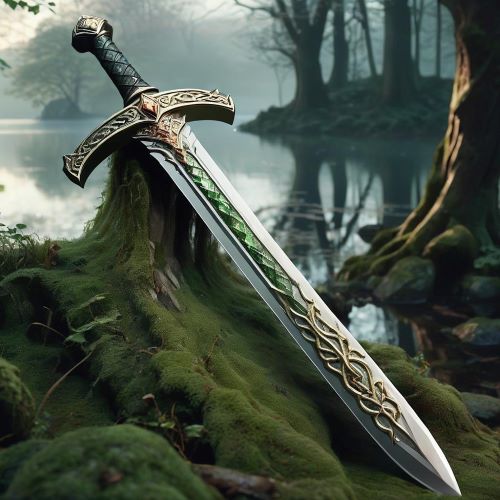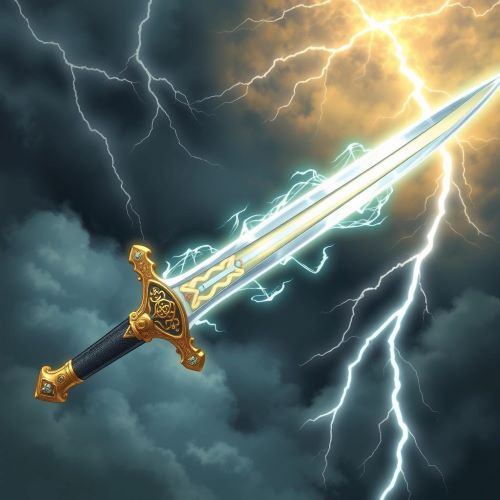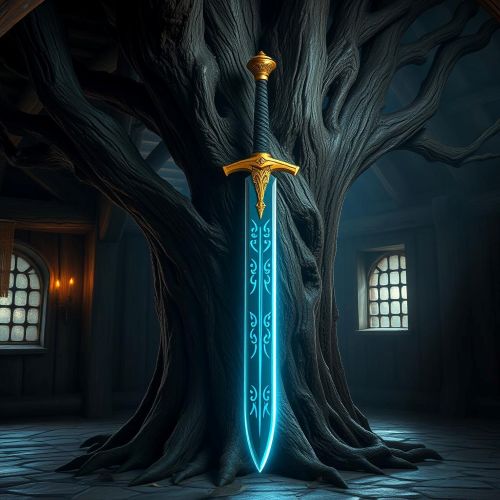Durandal : The French Excalibur
Durandal
Introduction
Durandal, the fabled sword wielded by Roland—the heroic paladin of Charlemagne—holds a distinguished place in French mythology and medieval literature. Revered not just as a weapon but as a divine symbol of valor and devotion, Durandal has captivated the imagination of generations. It plays a central role in the Chanson de Roland, an 11th-century epic that weaves myth with historical elements. With origins shrouded in legend and powers believed to be otherworldly, Durandal is a mythical relic that stands shoulder-to-shoulder with other iconic blades like Excalibur and Kusanagi.
Origins
The myth of Durandal begins with heavenly origins. In La Chanson de Roland, it is said that the sword was gifted to Charlemagne by an angel, marking it as a divine artifact even before it passed into the hands of Roland. Later legends elaborated on its creation, attributing it to Wayland the Smith—a mythical blacksmith also known in Germanic and Norse traditions for crafting magical weapons.
Durandal’s sacred significance was bolstered by what was believed to be contained in its hilt: a tooth of Saint Peter, blood of Saint Basil, hair from Saint Denis, and a fragment of the Virgin Mary’s robe. These relics were not just symbolic—they imbued the weapon with spiritual force and protection, reinforcing its divine favor.
The sword’s name likely derives from Old French “durant,” meaning enduring or steadfast, a fitting descriptor for a blade that outlasted its owner and, by legend, even time itself. According to folklore, when Roland tried to destroy the sword to prevent its capture, he failed—Durandal could not be broken.
Think you know your myths and legends? Dive into the world of ancient stories and test your knowledge with our engaging quizzes on Mythlok!
Powers
What makes Durandal stand out in the world of mythic weaponry is its indestructibility and unmatched sharpness. It could slice through armor, rock, and enemy lines without losing its edge. One of the most striking tales involves Roland attempting to shatter the blade on a stone outcrop when he realized his imminent death. Instead of breaking, the sword cut through the rock effortlessly. This feat cemented its supernatural status.
The sacred relics encased in the sword weren’t just decorative; they were believed to grant the blade miraculous qualities. It offered divine protection, as if the power of saints and the Virgin Mary themselves stood behind each of Roland’s swings. Thus, Durandal functioned not just as a tool of war, but as a heavenly instrument of justice.
Owners/Users
Though Charlemagne is believed to have initially owned Durandal, the sword is most famously associated with Roland, the paragon of knightly virtue. His unwavering loyalty to his king and unflinching bravery in the face of death made him a worthy bearer of such a sacred weapon.
Following Roland’s death at the Battle of Roncevaux Pass, the fate of the sword became a matter of enduring legend. According to local lore, Roland threw the sword into a cliff at Rocamadour, where it became lodged in the rock high above the ground. Pilgrims and travelers later visited this site, where a sword embedded in the cliff was displayed for centuries and identified as Durandal, further entwining the myth with geography and faith.
The Rocamadour relic turned Durandal into more than a literary symbol—it became a physical embodiment of French heritage. Even when the sword was reportedly stolen in recent years, it made headlines across the country, proving its status as a treasured cultural icon.
Instances used
Durandal’s most defining appearance remains in the Chanson de Roland, where it becomes both a weapon of war and a narrative device that reflects Roland’s nobility. During the final stand at Roncevaux Pass, Roland uses Durandal to devastating effect, cutting down enemy forces while refusing to blow his oliphant horn for reinforcements until it’s too late. His eventual attempt to destroy the sword—so it would not fall into Saracen hands—adds a layer of tragedy and reverence to the tale.
Beyond medieval poetry, Durandal features prominently in French folklore and oral storytelling. The symbolism attached to the sword influenced other cultures and inspired writers and creators of fantasy fiction. It has been compared to Excalibur in British lore and Joyeuse, Charlemagne’s own mythical sword.
In modern times, Durandal has appeared in literature, video games, and anime, where it often represents noble sacrifice, divine strength, and indestructibility. Despite the changing forms of media, its essence remains the same: a weapon not just of battle, but of divine resolve.
Frequently Asked Questions
Lorem ipsum dolor sit amet, consectetur adipiscing?
Lorem ipsum dolor sit amet, consectetur adipiscing elit. Praesent convallis vestibulum justo, ac tincidunt nunc vehicula quis. Nullam id dolor quis orci malesuada feugiat. Curabitur aliquet libero at urna ullamcorper, ac ultricies nulla dapibus.
Lorem ipsum dolor sit amet, consectetur adipiscing?
Lorem ipsum dolor sit amet, consectetur adipiscing elit. Praesent convallis vestibulum justo, ac tincidunt nunc vehicula quis. Nullam id dolor quis orci malesuada feugiat. Curabitur aliquet libero at urna ullamcorper, ac ultricies nulla dapibus.
Lorem ipsum dolor sit amet, consectetur adipiscing?
Lorem ipsum dolor sit amet, consectetur adipiscing elit. Praesent convallis vestibulum justo, ac tincidunt nunc vehicula quis. Nullam id dolor quis orci malesuada feugiat. Curabitur aliquet libero at urna ullamcorper, ac ultricies nulla dapibus.
Lorem ipsum dolor sit amet, consectetur adipiscing?
Lorem ipsum dolor sit amet, consectetur adipiscing elit. Praesent convallis vestibulum justo, ac tincidunt nunc vehicula quis. Nullam id dolor quis orci malesuada feugiat. Curabitur aliquet libero at urna ullamcorper, ac ultricies nulla dapibus.
Lorem ipsum dolor sit amet, consectetur adipiscing?
Lorem ipsum dolor sit amet, consectetur adipiscing elit. Praesent convallis vestibulum justo, ac tincidunt nunc vehicula quis. Nullam id dolor quis orci malesuada feugiat. Curabitur aliquet libero at urna ullamcorper, ac ultricies nulla dapibus.
Watch
Source
Rita Lejeune. (1954). Durandal: The Myth and Reality of Roland’s Sword. Paris: Éditions Gallimard.
La Chanson de Roland. (c. 11th century). Medieval French epic.
Rohlfs, G. (1972). Etymology and Symbolism in Medieval Literature. Oxford University Press.
Ancient Origins. (2024, July 4). Durandal, France’s Legendary Sword Stolen. Retrieved June 5, 2025, from https://www.ancient-origins.net/news-history-archaeology/durandal-frances-legendary-sword-stolen-021234
French Moments. (2024, July 10). The Legend of Durandal: Roland’s Magic Sword in Rocamadour. Retrieved June 5, 2025, from https://frenchmoments.eu/legend-durandal-rolands-magic-sword-rocamadour/
ASATours. (2024, December 18). La Chanson de Roland, the mythical paladin and his legendary sword Durandal. Retrieved June 5, 2025, from https://asatours.com/la-chanson-de-roland-mythical-paladin-durandal/
CUSU Journals. (2023). Sacred sword in the Germanic tribes and Germanic languages. Retrieved June 5, 2025, from https://cusujournals.org/sacred-sword-germanic-tribes-languages/
Museum Replicas. (n.d.). Durandal – Sword of Roland. Retrieved June 5, 2025, from https://www.museumreplicas.com/durandal-sword-roland
Local12. (2024, July 4). France’s ‘Excalibur’ sword vanishes from the stone after 1,300 years. Retrieved June 5, 2025, from https://local12.com/news/nation-world/france-excalibur-sword-vanishes-from-the-stone-after-1300-years








